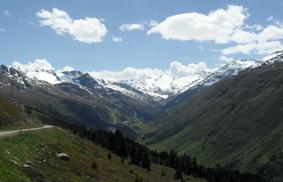 | ||
b2) As above, except turn west at Nassereith and drive through Landeck, then the Reschia pass/Resia into Italy. As long as you avoid the motorway and the tunnel bypassing Landeck, this does not require an Austrian Vignette and there is no charge for using the Reschia pass. This is somewhat slower than the Brenner and you often need winter tyres since the Reschia is quite high. If you were travelling, say, to Trento, the cost would only be just over 3 euro. | ||||||||
There are several options when driving a car from northern Europe to Italy. There are several options, depending on your circumstances: a) Need to arrive as quickly as possible: assuming you’re coming from the UK, Ireland, northern France, Belgium, Netherlands or western Germany, the French autoroutes offer the fastest transit times. However, they are toll roads (which also helps to limit traffic on them except in the summer peaks), so expect to pay tolls of over 135 euros getting to southern France (both Mont Blanc and Frejus tunnels are over 43 euros). The quickest route is probably via Modane and the Frejus Tunnel which brings you to Torino. b1) Luxembourg-Stuttgard-Ulm-Kempten (D)-Fussen (A)-Fern Pass-Innsbruck (A)-Brenner Pass (I). This has two advantages; firstly you can get very cheap petrol or diesel in Luxembourg and secondly, the German autobahn network is free for cars (not for commercial vehicles above a certain weight). However, this route involves the single-carriageway passage through Austria as far as near Innsbruck, even though the Fern Pass is open all year. It also means you need to buy an Austrian Vignette as soon as you get to their motorway (over €8.80 for 10 days), and then pay the Brenner highway charge, as well as the Italian autostrada charges (about 45 euros total to Trento). | ||||||||
